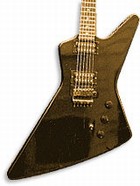
One of the unspoken assumptions in the vintage guitar market is American instruments are superior to those made outside the U.S. Regular “Gigmeister” readers know I don’t necessarily subscribe to that theory. In fact, many of the best-made instruments have come from Japan and occasionally, England. The decline in quality from Fender and Gibson in the ’70s gave way to better instruments in the ’80s.
The Hamer Blitz is an excellent example of an American-made instrument that can be had for well under $500 and offers craftsmanship rarely seen on instruments under $1,200. That means a true Gigmeister classic.
Paul Hamer and Jol Danzig began their careers fixing Gibson and Fender guitars in Chicago in the late ’60s and early ’70s. After doing enough to master their craft, they marketed an Explorer-shaped axe, called the Standard. It had a carved top, binding, and inlays to make it the fanciest (and priciest) Explorer-styled guitar of the disco days. Cheap Trick’s Rick Nielsen was featured in early magazine ads (sans hat) modeling the first Hamer. As Cheap Trick became famous, so did the Windy City duo, making unusual instruments for Nielsen, like the five-neck solidbody. Asked about Hamer, Nielsen said, “They are the only ones twisted enough to make these silly designs.”
Our current feature is much the same guitar, albeit less fancy, cosmetically. Bottom line: it’s still a Hamer, and that’s great!
Gibson pioneered the Explorer design in ’58, and the Blitz borrows heavily from some of its most endearing features, such as the 22-fret rosewood fingerboard and the customary 243/4″ scale pioneered in Kalamazoo. The fingerboard radius is flatter than a Fender, but not as level as a Charvel, making string bending comfortable. The neck and body are mahogany, a constant in the Hamer line. As their early-’80s catalog points out, “Any instrument must have a good acoustic sound before it can have a good electric sound. The neck joints are painstakingly hand-fitted and solidly glued for maximum resonance transmission.”
This instrument has a definite late-’80s vibe, from the six-on-a-side hockey stick headstock to the Floyd Rose locking tremolo. The aforementioned neck joint is an unfortunate weakness, as the neck can be pulled back, creating half step bends when hitting an open string. This is not Hamer’s fault, but simply a design flaw also prevalent with SGs, Firebirds and Flying Vs. The tuning gears look very Schaller-like, though they sport the Hamer name in very small print. Truss rod access is limited due to the locking nut installation, requiring the removal of three miniature screws and a long wrench. The headstock area looks weak, and with the holes drilled for the locking nut, this is not a guitar to be left lying on the floor! Fret work is excellent and, like Dean Zelinski, Hamer dressed the sides of the frets smoothly so they tumble down into the side of the neck. The neck is round but thin – an excellent shape for most players.
Hardware and plastic trim parts are all black, making this instrument with its black finish look like a Stealth fighter. The electronics look stock, but looks are often deceptive. Two DiMarzio specially designed humbuckers are wired to a three-way switch with dual volume and master tone controls. Just like early Dean guitars, the middle position selects both pickups out of phase! This is great for that Peter Green/T Bone Walker sound, but can be frustrating when you just want to play the opening lick to Steely Dan’s “Josie.” Here’s a little trick from Zelinski himself; turn either pickup volume control back slightly and the phase returns to normal! I owned a Dean Z (his version of the Explorer), and this Hamer feels almost identical. This is a neat way to get more than three sounds from your typical dual-humbucking-equipped guitar. Hamer put the selector switch above the tone and volume knobs, which varied from Gibson or Dean, who put it on the lower-cutaway horn.
The Floyd Rose tremolo is still state of the art for radical dive bombs, a full 20 years after its introduction. It’s not my favorite trem because it takes time and effort to adjust. However, once set, you can wang ’til the cows beg you to stop, and you’ll still be in tune. Just don’t pull a Steve Vai and lift the guitar by the trem arm, okay?
I love the sound of Gibson and Gibson-style guitars, so the Blitz made my ears happy right off the bat. The added out-of-phase tone makes the Blitz a bit more versatile than a typical dual-humbucker guitar. The DiMarzio pickups sound full and fat, and this shape is incredibly comfortable to play. In fact, the Explorer shape supports the right arm so well I think it’s the second most ergonomic guitar design around – next to the Stratocaster, of course. The Blitz is an excellent choice for taller-than-normal guitarists. My long arms feel very comfortable playing this shape, standing or seated. I encourage archtop and flat-top players who hate solidbody instruments to give it a try – you’ll feel quite comfortable. The Blitz does a fine job on any gig where you’d use dual humbuckers, including blues, pop, and jazz, but it certainly specializes in rock and metal.
I only have a few quibbles with the Blitz. As I said, I’d prefer a fixed bridge, and the headstock and neck joint could be beefed up for strength and stability. Of course, some players will be annoyed with the pickup wiring. These are just minor details, and I encourage you to play a Blitz for yourself. You won’t be sorry. Hats off to Hamer!
Special thanks to Doug Lawrance and LAWCO for the test instrument.
This article originally appeared in VG‘s June ’98 issue. All copyrights are by the author and Vintage Guitar magazine. Unauthorized replication or use is strictly prohibited.



